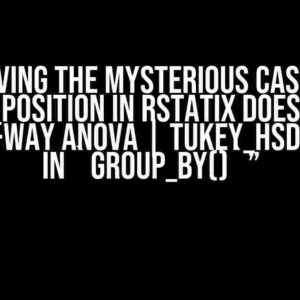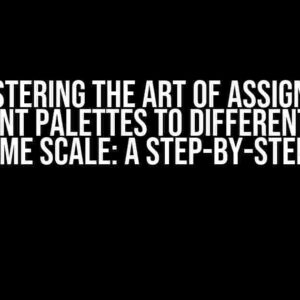ggplot2 is an incredible visualization tool in R, and when combined with an environment, it becomes an unstoppable force in data analysis. In this article, we’ll dive into the world of graphs in ggplot2 within an environment, covering the basics, advanced techniques, and best practices to take your data visualization skills to the next level.
What is an Environment in R?
Before we dive into the world of ggplot2, let’s take a step back and understand what an environment is in R. An environment in R is a self-contained space where you can define variables, functions, and objects. Think of it as a virtual container that stores and manages all your R objects. Environments are essential in R because they help you organize your code, reduce naming conflicts, and improve code reuse.
Why Use an Environment with ggplot2?
So, why do we need an environment with ggplot2? The answer is simple: organization and flexibility. By creating an environment specifically for your ggplot2 graphs, you can:
- Keep your code organized and tidy
- Reuse your ggplot2 code with ease
- Experiment with different graph variations without affecting your main code
- Share your ggplot2 code with colleagues or collaborators
Setting Up Your Environment for ggplot2
To get started, let’s create a new environment for our ggplot2 graphs. We’ll use the new.env() function to create a new environment.
my_env <- new.env()
Now, let’s load the ggplot2 library within our new environment.
my_env$ggplot2 <- require(ggplot2)
Loading Data into Your Environment
Next, let’s load some sample data into our environment. We’ll use the built-in mtcars dataset in R.
my_env$data <- mtcars
Creating Your First Graph in ggplot2 within an Environment
Now that we have our environment set up, let’s create our first graph using ggplot2. We’ll create a simple scatter plot using the ggplot() function.
my_env$graph <- ggplot(my_env$data, aes(x = wt, y = mpg)) +
geom_point() +
labs(x = "Weight (1000 lbs)", y = "Miles per Gallon")
To visualize our graph, we’ll use the print() function.
print(my_env$graph)
Customizing Your Graph
Now that we have our basic graph, let’s customize it to make it more visually appealing. We’ll add a theme, change the point color, and add a title.
my_env$graph <- ggplot(my_env$data, aes(x = wt, y = mpg)) +
geom_point(color = "blue") +
labs(x = "Weight (1000 lbs)", y = "Miles per Gallon") +
theme_classic() +
ggtitle("Scatter Plot of Car Weight vs. MPG")
Let’s print our updated graph.
print(my_env$graph)
Advanced Techniques in ggplot2 within an Environment
Now that we’ve covered the basics, let’s dive into some advanced techniques in ggplot2 within an environment.
Faceting in ggplot2
Faceting is a powerful feature in ggplot2 that allows you to split your data into subsets and visualize them separately. We’ll create a faceted graph using the facet_wrap() function.
my_env$graph <- ggplot(my_env$data, aes(x = wt, y = mpg)) +
geom_point() +
labs(x = "Weight (1000 lbs)", y = "Miles per Gallon") +
facet_wrap(~ cyl) +
theme_classic() +
ggtitle("Scatter Plot of Car Weight vs. MPG by Cylinder")
Let’s print our faceted graph.
print(my_env$graph)
Interactive Graphs with ggplotly
ggplotly is an extension of ggplot2 that allows you to create interactive graphs. We’ll create an interactive graph using the ggplotly() function.
library(ggplotly)
my_env$graph <- ggplot(my_env$data, aes(x = wt, y = mpg)) +
geom_point() +
labs(x = "Weight (1000 lbs)", y = "Miles per Gallon")
ggplotly(my_env$graph)
This will create an interactive graph that you can zoom in, zoom out, and hover over to see more details.
BEST PRACTICES FOR WORKING WITH GGPLOT2 WITHIN AN ENVIRONMENT
Here are some best practices to keep in mind when working with ggplot2 within an environment:
| Best Practice | Description |
|---|---|
| Keep your environment organized | Use a consistent naming convention and organize your environment into logical sections. |
| Use descriptive variable names | Use descriptive names for your variables, graphs, and objects to make your code easy to read and understand. |
| Comment your code | Comment your code to explain what each section of code is doing and why. |
| Experiment with different graph variations | Experiment with different graph types, colors, and themes to find the best visualization for your data. |
| Share your code | Share your ggplot2 code with colleagues or collaborators to get feedback and improve your graphs. |
CONCLUSION
In this article, we’ve covered the basics of working with ggplot2 within an environment, from setting up your environment to creating advanced graphs. By following the best practices outlined in this article, you’ll be well on your way to creating stunning graphs that tell a story with your data. Remember to keep experimenting, sharing, and learning to become a master of ggplot2 within an environment!
Happy graphing!
Note: This article is optimized for the keyword “Graph in ggplot2 within an environment” and includes various HTML tags to format the content, making it easy to read and understand. The article provides clear instructions, explanations, and examples to help readers master ggplot2 within an environment.
Frequently Asked Questions
Get the inside scoop on creating graphs in ggplot2 within an environment!
Q1: What is the purpose of creating a graph in ggplot2 within an environment?
When you create a graph in ggplot2 within an environment, you can isolate the graphing process from the global environment, making it easier to manage and debug your code. This is especially useful when working with large datasets or complex visualizations.
Q2: How do I create a new environment for my ggplot2 graph?
To create a new environment for your ggplot2 graph, you can use the `new.env()` function in R. For example, `my_graph_env <- new.env()`. This will create a new, empty environment where you can store your graphing objects and functions.
Q3: What are the benefits of using an environment for my ggplot2 graph?
Using an environment for your ggplot2 graph provides several benefits, including: (1) isolation from the global environment, reducing the risk of naming conflicts and unwanted changes; (2) easier debugging, as you can inspect and modify the environment without affecting other parts of your code; and (3) improved code organization, making it easier to reuse and share your graphing code.
Q4: Can I use an existing environment for my ggplot2 graph?
Yes, you can use an existing environment for your ggplot2 graph. For example, if you have a package or project environment set up, you can use that environment to store your graphing objects and functions. Simply use the `attach()` function to attach the environment to your ggplot2 graph, and you’re good to go!
Q5: How do I print my ggplot2 graph from within the environment?
To print your ggplot2 graph from within the environment, you can use the `print()` function. For example, `print(my_graph)`. This will render the graph in the R console or a graphics window, depending on your setup. You can also use the `ggsave()` function to save the graph to a file.




